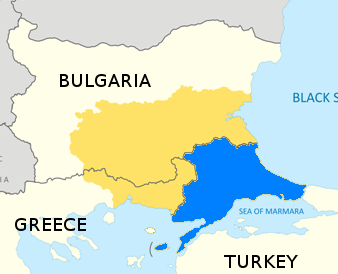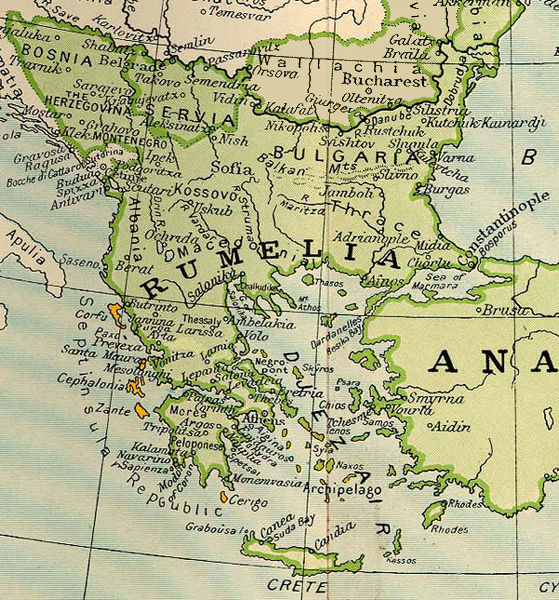|
Thrace
Thrace (, ; ; ; ) is a geographical and historical region in Southeast Europe roughly corresponding to the province of Thrace in the Roman Empire. Bounded by the Balkan Mountains to the north, the Aegean Sea to the south, and the Black Sea to the east, it comprises present-day southeastern Bulgaria (Northern Thrace), northeastern Greece (Western Thrace), and the European part of Turkey (East Thrace). Lands also inhabited by ancient Thracians extended in the north to modern-day Northern Bulgaria and Romania and to the west into Macedonia (region), Macedonia. Etymology The word ''Thrace'', from ancient Greek ''Thrake'' (Θρᾴκη), referred originally to the Thracians (ancient Greek ''Thrakes'' Θρᾷκες), an ancient people inhabiting Southeast Europe. The name ''Europe'' (ancient Greek Εὐρώπη), also at first referred to this region, before that term expanded to include its Europe, modern sense. It has been suggested that the name ''Thrace'' derives from the na ... [...More Info...] [...Related Items...] OR: [Wikipedia] [Google] [Baidu] |
Thracians
The Thracians (; ; ) were an Indo-European languages, Indo-European speaking people who inhabited large parts of Southeast Europe in ancient history.. "The Thracians were an Indo-European people who occupied the area that today is shared between Thrace, north-eastern Greece, Romania, and north-western Turkey. They shared the same language and culture. There may have been as many as a million Thracians, divided among up to 40 tribes." Thracians resided mainly in Southeast Europe in Present (time), modern-day Bulgaria, Romania, North Macedonia, northern Greece and European Turkey, but also in north-western Anatolia, Anatolia (Asia Minor) in Turkey. The exact origin of the Thracians is uncertain, but it is believed that Thracians like other Indo-European speaking groups in Europe descended from a mixture of Proto-Indo-Europeans and Early European Farmers. Around the 5th millennium BC, the inhabitants of the eastern region of the Balkans became organized in different groups of Indi ... [...More Info...] [...Related Items...] OR: [Wikipedia] [Google] [Baidu] |
Western Thrace
Western Thrace or West Thrace (, '' ytikíThráki'' ), also known as Greek Thrace or Aegean Thrace, is a geographical and historical region of Greece, between the Nestos and Evros rivers in the northeast of the country; East Thrace, which lies east of the river Evros, forms the European part of Turkey, and the area to the north, in Bulgaria, is known as Northern Thrace. Inhabited since Paleolithic times, it has been under the political, cultural and linguistic influence of the Greek world since the classical era; Greeks from the Aegean islands extensively colonized the region (especially the coastal part) and built prosperous cities such as Abdera (home of Democritus, the 5th-century BC philosopher who developed an atomic particle theory, and of Protagoras, a leading sophist) and Sale (near present-day Alexandroupolis). Under the Byzantine Empire, Western Thrace benefited from its position close to the imperial heartland and became a center of medieval Greek commerce and ... [...More Info...] [...Related Items...] OR: [Wikipedia] [Google] [Baidu] |
East Thrace
East Thrace or Eastern Thrace, also known as Turkish Thrace or European Turkey, is the part of Turkey that is geographically in Southeast Europe. Turkish Thrace accounts for 3.03% of Turkey's land area and 15% of its population. The largest city is Istanbul, which straddles the Bosporus between Europe and Asia. East Thrace is of historic importance as it is next to a major sea trade corridor and constitutes what remains of the once-vast Ottoman region of Rumelia. It is currently also of specific geostrategic importance because the sea corridor, which includes two narrow straits, provides access to the Mediterranean Sea from the Black Sea for the navies of five countries: Russia, Ukraine, Romania, Bulgaria, and Georgia (country), Georgia. The region also serves as a future connector of existing Turkish, Bulgarian, and Greek high-speed rail networks. Due to the guest worker agreement with Turkey and Germany, some Turks in Germany originally come from Eastern Thrace, mostly fr ... [...More Info...] [...Related Items...] OR: [Wikipedia] [Google] [Baidu] |
Northern Thrace
Northern Thrace or North Thrace (, ; ; ), also called Bulgarian Thrace, constitutes the northern and largest part of the historical region of Thrace. It is located in Southern Bulgaria and includes the territory south of the Balkan Mountains and east of the Mesta River, bordering Western Thrace and East Thrace in the south, and the Black Sea in the east. It encompasses Sredna Gora, the Upper Thracian Plain, and 90% of the Rhodopes. The climate ranges from subtropical to transitional continental and mountainous. The highest temperature recorded in Bulgaria occurred here: it was at Sadovo in 1916. The main rivers of the region are the Maritsa and its tributaries. Notable cities include Plovdiv, Burgas, Stara Zagora, Sliven, Haskovo, Yambol, Pazardzhik, Asenovgrad, Kardzhali, Dimitrovgrad, Kazanlak and Smolyan. Northern Thrace has an area of 42,073 km2. The Ottoman Empire created the autonomous province of the newly-named Eastern Rumelia in Northern Thrace in 1878. ... [...More Info...] [...Related Items...] OR: [Wikipedia] [Google] [Baidu] |
Macedonia (region)
Macedonia ( ) is a geographical and historical region of the Balkan Peninsula in Southeast Europe. Its boundaries have changed considerably over time; however, it came to be defined as the modern geographical region by the mid-19th century. Today the region is considered to include parts of six Balkan countries: all of North Macedonia, large parts of Greece and Bulgaria, and smaller parts of Albania, Serbia, and Kosovo. It covers approximately and has a population of around five million. Macedonia (Greece), Greek Macedonia comprises about half of Macedonia's area and population. Its oldest known settlements date back approximately to 7,000 BC. From the middle of the 4th century BC, the Kingdom of Macedon became the dominant power on the Balkan Peninsula; since then Macedonia has had a diverse history. Etymology Both proper nouns ''Makedṓn'' and ''Makednós'' are morphologically derived from the Ancient Greek adjective ''makednós'' meaning "tall, slim", and are related t ... [...More Info...] [...Related Items...] OR: [Wikipedia] [Google] [Baidu] |
Balkans AD125
The Balkans ( , ), corresponding partially with the Balkan Peninsula, is a geographical area in southeastern Europe with various geographical and historical definitions. The region takes its name from the Balkan Mountains that stretch throughout the whole of Bulgaria. The Balkan Peninsula is bordered by the Adriatic Sea in the northwest, the Ionian Sea in the southwest, the Aegean Sea in the south, the Turkish straits in the east, and the Black Sea in the northeast. The northern border of the peninsula is variously defined. The highest point of the Balkans is Musala, , in the Rila mountain range, Bulgaria. The concept of the Balkan Peninsula was created by the German geographer August Zeune in 1808, who mistakenly considered the Balkan Mountains the dominant mountain system of southeastern Europe spanning from the Adriatic Sea to the Black Sea. In the 19th century the term ''Balkan Peninsula'' was a synonym for Rumelia, the parts of Europe that were provinces of the Ottoman ... [...More Info...] [...Related Items...] OR: [Wikipedia] [Google] [Baidu] |
Thracian Language
The Thracian language () is an extinct and Attested language, poorly attested language, spoken in ancient times in Southeast Europe by the Thracians. The linguistic affinities of the Thracian language are Classification of Thracian, poorly understood, but it is generally agreed that it was an Indo-European languages, Indo-European language. The point at which Thracian became extinct is a matter of dispute. However, it is generally accepted that Thracian was still in use in the 6th century AD: Antoninus of Piacenza (pilgrim), Antoninus of Piacenza wrote in 570 that there was a monastery in the Sinai Peninsula, Sinai, at which the monks spoke Koine Greek, Greek, Latin, Syriac language, Syriac, Coptic language, Egyptian, and Bessian – a Thracian dialect. A classification put forward by Harvey Mayer, suggests that Thracian (and Dacian language, Dacian) belonged to the Baltic languages, Baltic branch of Indo-European, or at least is closer to Baltic than any other Indo-European br ... [...More Info...] [...Related Items...] OR: [Wikipedia] [Google] [Baidu] |
Rumeli
Rumelia (; ; ) was a historical region in Southeastern Europe that was administered by the Ottoman Empire, roughly corresponding to the Balkans. In its wider sense, it was used to refer to all Ottoman possessions and vassals in Europe. These would later be geopolitically classified as "the Balkans", although Hungary and Moldova are sometimes excluded. In contemporary English sources, Rumelia was known as Turkey in Europe. Etymology '' Rûm'' in this context means 'Roman' and ''ėli'' means 'land', and thus ''Rumelia'' (, ''Rūm-ėli''; Turkish: ''Rumeli'') means 'Land of the Romans' in Ottoman Turkish. It refers to the lands conquered by the Ottoman Empire in the Balkans, most of which formerly belonged to the Byzantine Empire, known by its contemporaries as the Roman Empire. Although the term ''Byzantine Empire'' is used by modern historians, the empire's citizens and emperors called themselves Romans, meaning Greek-speaking Eastern Romans, and embraced a Christian identi ... [...More Info...] [...Related Items...] OR: [Wikipedia] [Google] [Baidu] |
Byzantine Macedonia 1045CE
The Byzantine Empire, also known as the Eastern Roman Empire, was the continuation of the Roman Empire centred on Constantinople during late antiquity and the Middle Ages. Having survived the events that caused the fall of the Western Roman Empire in the 5th centuryAD, it endured until the fall of Constantinople to the Ottoman Empire in 1453. The term 'Byzantine Empire' was coined only after its demise; its citizens used the term 'Roman Empire' and called themselves 'Romans'. During the early centuries of the Roman Empire, the western provinces were Latinised, but the eastern parts kept their Hellenistic culture. Constantine I () legalised Christianity and moved the capital to Constantinople. Theodosius I () made Christianity the state religion and Greek gradually replaced Latin for official use. The empire adopted a defensive strategy and, throughout its remaining history, experienced recurring cycles of decline and recovery. It reached its greatest extent unde ... [...More Info...] [...Related Items...] OR: [Wikipedia] [Google] [Baidu] |
Thrace (mythology)
Thrace (; Modern ''Thráki'';) or Thraike in Greek mythology, was the eponymous heroine and sorceress of Thrace. She was the daughter of Oceanus and Parthenope, and sister of Europa. Some of her half-sisters were Asia and Libya.Tzetzes ad Lycophron894fr. 7 Fowler= ''FGrHist ''Die Fragmente der griechischen Historiker'', commonly abbreviated ''FGrHist'' or ''FGrH'' (''Fragments of the Greek Historians''), is a collection by Felix Jacoby of the works of those ancient Greek historians whose works have been lost, but o ...'' 10 F 7 (Fowler 2000p. 42 Fowler 2013p. 13 Bouzek and Graningerp. 12 Fowler 2013, p. 15, calls Parthenope, "elsewhere variously a Siren, a daughter of Ankaios, and a paramour of Herakles" an ''ad hoc'' invention.) Notes References * Grimal, Pierre, ''The Dictionary of Classical Mythology'', Wiley-Blackwell, 1996. Greek mythological witches Oceanids Children of Oceanus Mythological Thracian women {{Greek-deity-stub ... [...More Info...] [...Related Items...] OR: [Wikipedia] [Google] [Baidu] |
Byzantine Empire
The Byzantine Empire, also known as the Eastern Roman Empire, was the continuation of the Roman Empire centred on Constantinople during late antiquity and the Middle Ages. Having survived History of the Roman Empire, the events that caused the fall of the Western Roman Empire in the 5th centuryAD, it endured until the fall of Constantinople to the Ottoman Empire in 1453. The term 'Byzantine Empire' was coined only after its demise; its citizens used the term 'Roman Empire' and called themselves 'Romans'. During the early centuries of the Roman Empire, the western provinces were Romanization (cultural), Latinised, but the eastern parts kept their Hellenistic culture. Constantine the Great, Constantine I () legalised Christianity and moved the capital to Constantinople. Theodosius I, Theodosius I () made Christianity the state religion and Greek gradually replaced Latin for official use. The empire adopted a defensive strategy and, throughout its remaining history, expe ... [...More Info...] [...Related Items...] OR: [Wikipedia] [Google] [Baidu] |








